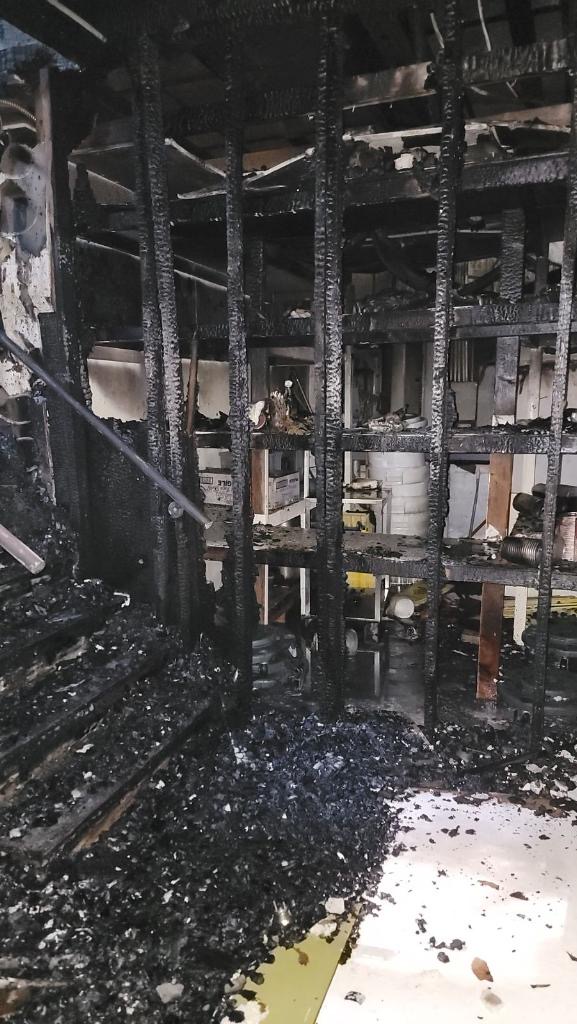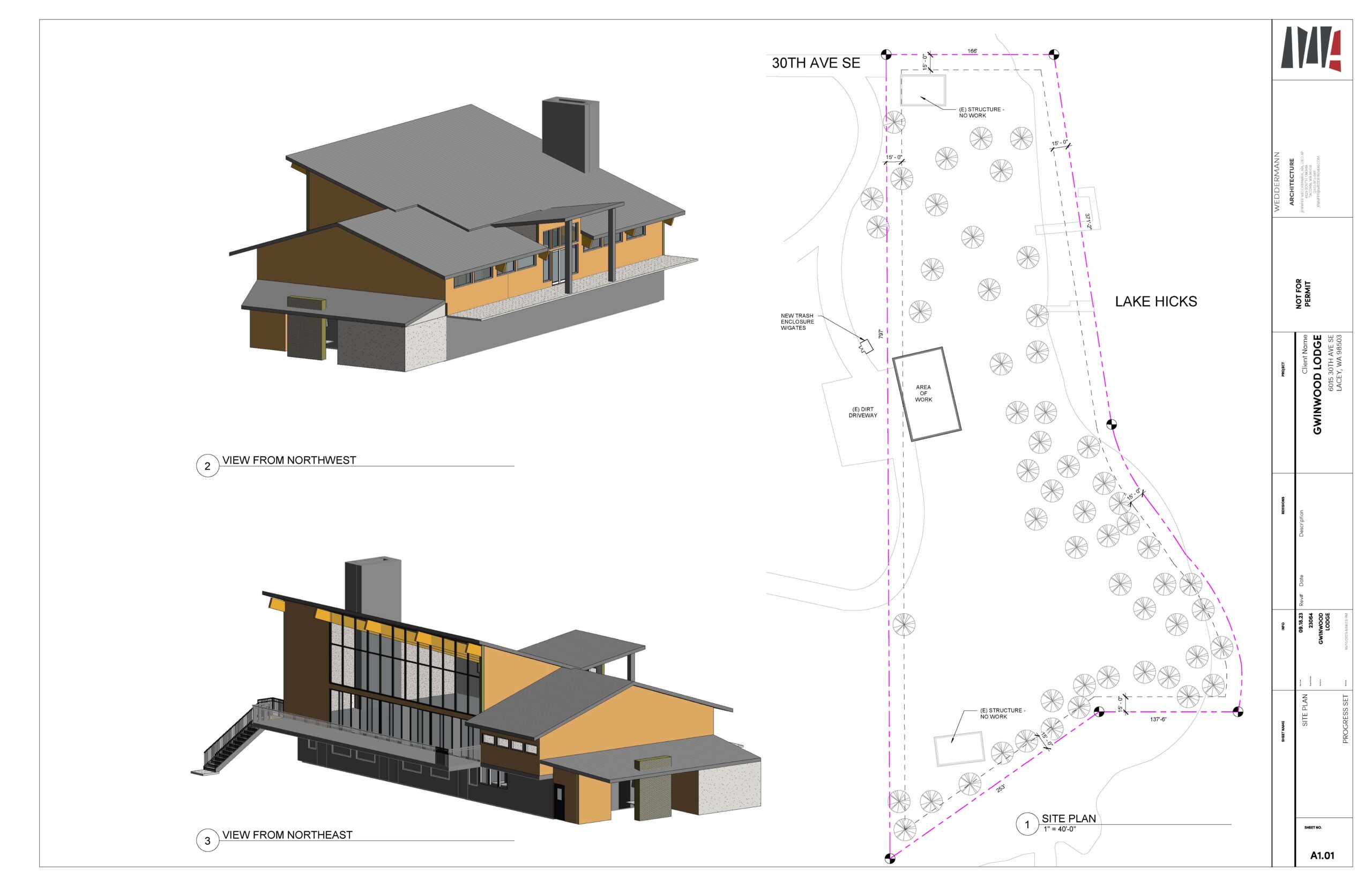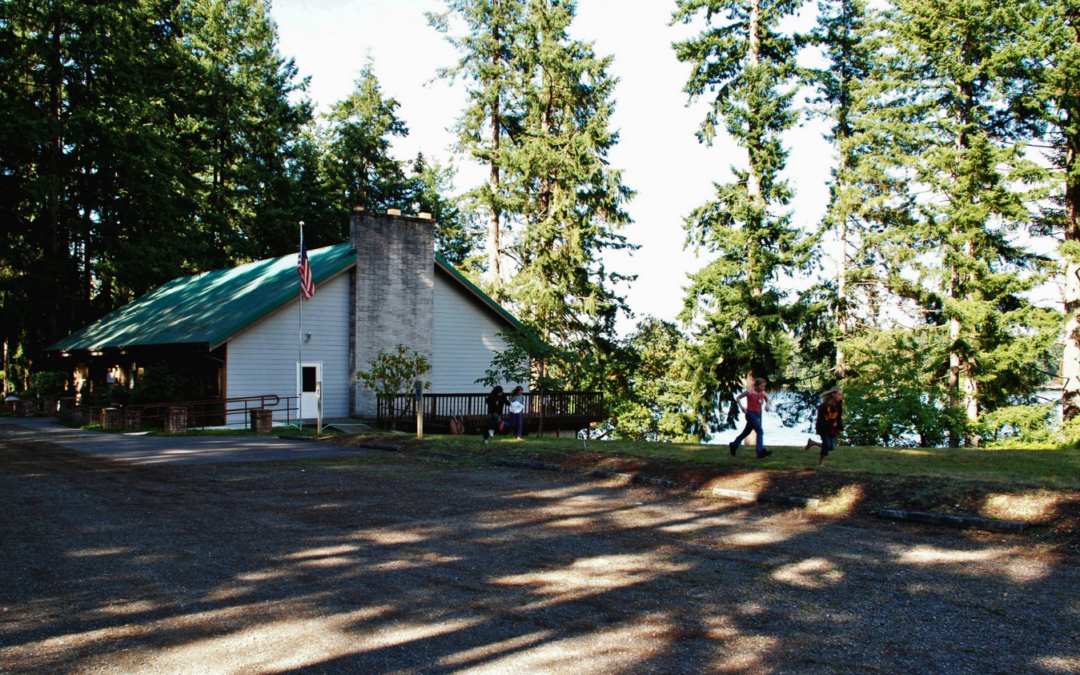Gwinwood Retreat Center, a Christian Church (Disciples of Christ) camp in the Northern Lights Region, sits on 29 acres of forested land right at the edge of Hicks Lake in Lacey, WA. It’s surrounded on three sides by wetlands and on a good day, you can see Mt. Rainier in the distance.
 But on July 4, the only thing Gwinwood’s neighbors across the water could see was smoke.
But on July 4, the only thing Gwinwood’s neighbors across the water could see was smoke.
The church camp’s largest meeting space, MacKinnon Lodge, was in flames.
You’d think that the fire would spell nothing but disaster for Gwinwood, one of the very few Disciples retreat centers that made it through the COVID-19 pandemic thanks to an emergency loan from Disciples Church Extension Fund (DCEF). Yet its staff and directors have taken this tragedy and turned it into an opportunity to partner with DCEF once again and dream big – to change not only MacKinnon, but the camp itself.
The retreat center’s property was bought for $4,000 in 1947 as a post-war bid to provide a space of restoration for the next generation of Disciples. To this day, there are no telephones nor televisions on the grounds, and Wi-Fi is not guaranteed. That’s not to say that Gwinwood is isolated – it’s only a seven-minute drive to the closest Target – but the pocket of old-growth forest that the center is nestled in has made it an ideal summer getaway, not only for the 29 congregations on the western side of the Cascade mountains that own it, but for other individuals and local organizations as well.
“MacKinnon was emblematic of the camp,” explains John Richards, the chairman of the board of trustees. “When people thought of Gwinwood, they thought of MacKinnon.”
 There are 17 buildings on the property, including Westwood, a conference center tucked away in the woods. But with the camp’s primary dining room and kitchen on the lower level, an expansive event space on the upper level, and a panoramic view of the water, MacKinnon was the main activities building.
There are 17 buildings on the property, including Westwood, a conference center tucked away in the woods. But with the camp’s primary dining room and kitchen on the lower level, an expansive event space on the upper level, and a panoramic view of the water, MacKinnon was the main activities building.
The City Fire Marshall believes that a faulty light fixture in a restroom located underneath the main stairway is likely the ignition point and the cause of the fire.
“That fixture could have been changed years ago to more modern technology,” points out Jim Michel, DCEF Building and Capital Services Advisor and Building Disaster Response Coordinator. “Most church fires are man-made and not nature-caused. It goes back to a belief that everything will last forever.”
 Thankfully no one was present at the camp when disaster struck, but by the time the fire department arrived at the scene, MacKinnon was fully engulfed. Several hours later, and with almost 20 trucks working on the blaze, the fire was contained, but the lodge was deemed a total loss. As the camp’s executive director, Kate Ayers was the first staff member to be called.
Thankfully no one was present at the camp when disaster struck, but by the time the fire department arrived at the scene, MacKinnon was fully engulfed. Several hours later, and with almost 20 trucks working on the blaze, the fire was contained, but the lodge was deemed a total loss. As the camp’s executive director, Kate Ayers was the first staff member to be called.
“As I was standing there watching it burn, I thought, ‘Now what?’” she recalls. “Then something shifted in me. We were being given a chance to construct a building that is forward-thinking and inclusive, which is very important to Disciples. This could be an opening up of who we are.”
Three days later, after the insurance adjuster and city officials conducted a site walk-through, Kate contacted Jim on the recommendation of Interim Northern Lights Regional Minister Rev. Bill Robey. As he does with all congregations, camps, and other Disciples organizations that reach out to him following a disaster, Jim went over what Kate and her colleagues needed to do:
- No matter how much they wanted to go back into the building to save something and no matter how much insurance restoration companies guaranteed that they could clean and salvage items, they should avoid doing so because MacKinnon was now a hazardous waste site. Not only was it unsafe due to weak structural integrity, but the fire had created dangerous smoke and soot that soft materials had absorbed.
- Once the structural engineer had inspected the building and the fire marshal permitted them to do so, staff could enter the site to compile a detailed list of what was in the facility. This process would allow them to determine the value of each item. Assign a staff member or volunteer to look up the value of each item online.
- Hire an architect, whether they were going to erect a new structure or rebuild what was left. The ideal candidate would be the principal architect of a small firm within the vicinity.
 Following Jim’s advice, Kate and her team decided to demolish the old MacKinnon facility and hired Jennifer Weddermann, an architect who has experience working with non-profit organizations, to design a building that was up to code, fully accessible, had appropriate heat, and with a kitchen that could accommodate large groups. So far, she has provided Gwinwood with preliminary drawings for a much brighter, open, and energy-efficient building that will offer a better view of the lake from the rear.
Following Jim’s advice, Kate and her team decided to demolish the old MacKinnon facility and hired Jennifer Weddermann, an architect who has experience working with non-profit organizations, to design a building that was up to code, fully accessible, had appropriate heat, and with a kitchen that could accommodate large groups. So far, she has provided Gwinwood with preliminary drawings for a much brighter, open, and energy-efficient building that will offer a better view of the lake from the rear.
On his end, Jim continues to guide John and his team in conversations with the adjuster to identify what the insurance company can pay for, what it can’t, and why. This will help them to provide Jennifer and the contractor with a more accurate number for the new structure. As Gwinwood waits to see how much of the rebuilding costs insurance will cover, they have invested the bulk of the financial gifts they have received since the fire in interest-earning Investment Notes at DCEF.
“I have a great board, but none of us have dealt with anything like this,” confesses Kate. “Jim has shown us how all the pieces come together. Something bigger is at work and he is at the center of it all.”
 In November, Jim visited Gwinwood for its annual meeting, where he, the camp’s board of directors, and the Christian Church Foundation reviewed Jennifer’s report, which included the conceptual phase drawings. As he toured the site, he noticed new growth peeking out from underneath pine needles that had fallen beside the scorched remains of MacKinnon – a fitting image, as the Gwinwood team hopes to start building a new structure in the spring.
In November, Jim visited Gwinwood for its annual meeting, where he, the camp’s board of directors, and the Christian Church Foundation reviewed Jennifer’s report, which included the conceptual phase drawings. As he toured the site, he noticed new growth peeking out from underneath pine needles that had fallen beside the scorched remains of MacKinnon – a fitting image, as the Gwinwood team hopes to start building a new structure in the spring.
“Even though there was virtually nothing of the building that could be salvaged,” remembers Jim, “the memories that so many have of this place will always be there, never forgotten. Now the new building will be better than what was there before, and new memories can be made.”
Has your place of worship, camp, or other facility been damaged by a tornado, earthquake, or fire? DCEF can help.
Through the generosity of our donors, we offer the Building Disaster Response Service at no charge to congregations and other organizations, so they can focus on their ministry. If you would like to support this work, consider participating in our New Ways into the World campaign, which will provide funds to sustain our work with congregations dealing with the devastating impact of a disaster.


A very nice story of hope and recovery. I’m glad you included it in the sermon series on the Psalms. I will endeavor to use it in a future sermon. I have had similar connections to “sacred camps and spaces.” Many Disciples in the Los Angeles area look to Loch Leven as a special retreat center. For many years I was a participant in Disciple Family Fellowship in Southern California. We used a camp owned by the City of Los Angeles (although in San Bernardino County) for our large, annual conferences. It was called Camp Seely and the trail leading to Heart Rock (a natural formation you can see on-line) was easy and led to an incredible sight. Texas Disciples have a connecting point in their camp in Athens, Texas. And Virginia Disciples revere Craig Springs in the mountains above Roanoke, VA.
Thank you for sharing your experiences Rev. Timothy! Do let us know if you use this story in a future sermon.